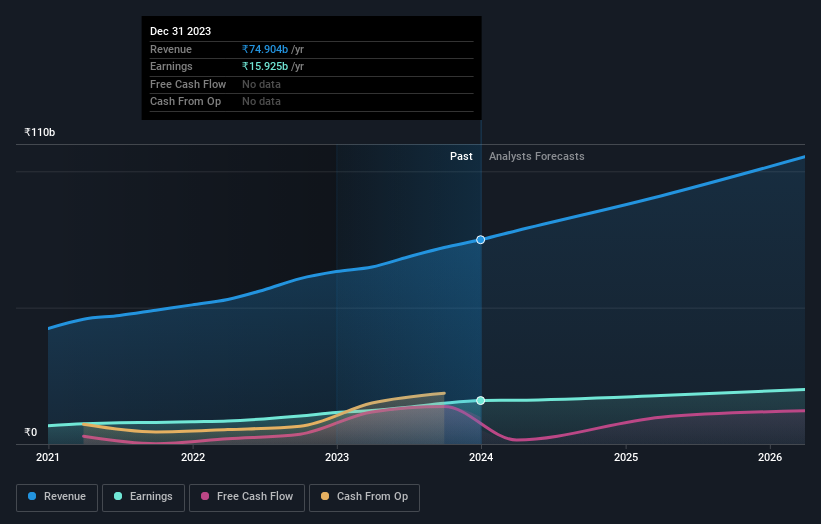Stock Analysis
With 47% ownership, PI Industries Limited (NSE:PIIND) insiders have a lot riding on the company's future

Key Insights
- PI Industries' significant insider ownership suggests inherent interests in company's expansion
- The top 3 shareholders own 51% of the company
- Institutional ownership in PI Industries is 29%
Every investor in PI Industries Limited (NSE:PIIND) should be aware of the most powerful shareholder groups. And the group that holds the biggest piece of the pie are individual insiders with 47% ownership. In other words, the group stands to gain the most (or lose the most) from their investment into the company.
So, insiders of PI Industries have a lot at stake and every decision they make on the company’s future is important to them from a financial point of view.
In the chart below, we zoom in on the different ownership groups of PI Industries.
See our latest analysis for PI Industries

What Does The Institutional Ownership Tell Us About PI Industries?
Institutional investors commonly compare their own returns to the returns of a commonly followed index. So they generally do consider buying larger companies that are included in the relevant benchmark index.
As you can see, institutional investors have a fair amount of stake in PI Industries. This can indicate that the company has a certain degree of credibility in the investment community. However, it is best to be wary of relying on the supposed validation that comes with institutional investors. They too, get it wrong sometimes. If multiple institutions change their view on a stock at the same time, you could see the share price drop fast. It's therefore worth looking at PI Industries' earnings history below. Of course, the future is what really matters.

Hedge funds don't have many shares in PI Industries. Salil Singhal is currently the largest shareholder, with 26% of shares outstanding. For context, the second largest shareholder holds about 20% of the shares outstanding, followed by an ownership of 4.9% by the third-largest shareholder. Mayank Singhal, who is the second-largest shareholder, also happens to hold the title of Co-Chief Executive Officer.
After doing some more digging, we found that the top 3 shareholders collectively control more than half of the company's shares, implying that they have considerable power to influence the company's decisions.
Researching institutional ownership is a good way to gauge and filter a stock's expected performance. The same can be achieved by studying analyst sentiments. There are a reasonable number of analysts covering the stock, so it might be useful to find out their aggregate view on the future.
Insider Ownership Of PI Industries
The definition of company insiders can be subjective and does vary between jurisdictions. Our data reflects individual insiders, capturing board members at the very least. Management ultimately answers to the board. However, it is not uncommon for managers to be executive board members, especially if they are a founder or the CEO.
Insider ownership is positive when it signals leadership are thinking like the true owners of the company. However, high insider ownership can also give immense power to a small group within the company. This can be negative in some circumstances.
Our information suggests that insiders maintain a significant holding in PI Industries Limited. It is very interesting to see that insiders have a meaningful ₹267b stake in this ₹573b business. Most would be pleased to see the board is investing alongside them. You may wish to access this free chart showing recent trading by insiders.
General Public Ownership
The general public, who are usually individual investors, hold a 24% stake in PI Industries. This size of ownership, while considerable, may not be enough to change company policy if the decision is not in sync with other large shareholders.
Next Steps:
It's always worth thinking about the different groups who own shares in a company. But to understand PI Industries better, we need to consider many other factors. Case in point: We've spotted 1 warning sign for PI Industries you should be aware of.
If you are like me, you may want to think about whether this company will grow or shrink. Luckily, you can check this free report showing analyst forecasts for its future.
NB: Figures in this article are calculated using data from the last twelve months, which refer to the 12-month period ending on the last date of the month the financial statement is dated. This may not be consistent with full year annual report figures.
Valuation is complex, but we're helping make it simple.
Find out whether PI Industries is potentially over or undervalued by checking out our comprehensive analysis, which includes fair value estimates, risks and warnings, dividends, insider transactions and financial health.
View the Free AnalysisHave feedback on this article? Concerned about the content? Get in touch with us directly. Alternatively, email editorial-team (at) simplywallst.com.
This article by Simply Wall St is general in nature. We provide commentary based on historical data and analyst forecasts only using an unbiased methodology and our articles are not intended to be financial advice. It does not constitute a recommendation to buy or sell any stock, and does not take account of your objectives, or your financial situation. We aim to bring you long-term focused analysis driven by fundamental data. Note that our analysis may not factor in the latest price-sensitive company announcements or qualitative material. Simply Wall St has no position in any stocks mentioned.
About NSEI:PIIND
PI Industries
PI Industries Limited manufactures and distributes agrochemicals in India, rest of Asia, North America, Europe, and internationally.
Flawless balance sheet with solid track record and pays a dividend.

